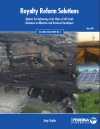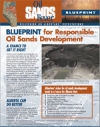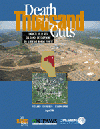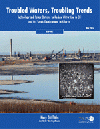$ 123,496,878
 Read Dan Woynillowicz's (of Pembina) article: Tar Sands Fever in the Sep/Oct issue of World Watch Magazine. |
Publications
Refine Publication Search

Published: Jun 11, 2007 By: Natural Resources Defense Council (NRDC), Dan Woynillowicz The report, Driving it Home: Choosing the Right Path for Fuelling North America's Transportation Future, describes the stark energy crossroads that North America faces. Researched and written by the NRDC, Western Resources Advocates (WRA) - both American-based environmental groups - and the Calgary-based Pembina Institute. Publication Type: Reports, Backgrounders & Position Papers Topic Area: Oil Sands Royalty Reform Solutions (Full Report and Fact Sheet)Options for Delivering a Fair Share of Oil Sands Revenues to Albertans and Resource Developers

Published: May 24, 2007 By: Amy Taylor This report describes several options that Albertans, when thinking like owners, can consider for reforming the oil sands royalty regime. The reforms are designed to ensure better value to Albertans while maintaining a reasonable profit for oil sands companies. Publication Type: Reports, Backgrounders & Position Papers Topic Area: Oil Sands Models for Oil Sands Royalty ReformDetailed Royalty Reform Results and Assumptions

Published: May 24, 2007 By: Amy Taylor This technical background paper accompanies a report entitled Royalty Reform Solutions: Options for Delivering a Fair Share of Oil Sands Revenues to Albertans and Resource Developers. Publication Type: Reports, Backgrounders & Position Papers Topic Area: Oil Sands 
Published: Apr 2, 2007 By: Dan Woynillowicz In response to Phase II of the Alberta Oil Sands Consultations, the Pembina Institute released this blueprint that calls for a moratorium on new oil sands project approvals and lease sales until six key requirements for responsible development are addressed. Publication Type: Reports, Backgrounders & Position Papers Topic Area: Oil Sands 
Published: Aug 1, 2006 By: Simon Dyer The Pembina Institute's new book Death by a Thousand Cuts: The Impacts of In Situ Oil Sands Development on Alberta's Boreal Forest examines the environmental impacts of in situ (in place) development of deep oil sands that has the potential to affect a forested region 50 times larger than the areas leased for oil sands mining north of Fort McMurray. Publication Type: Reports, Backgrounders & Position Papers Topic Area: Oil Sands 
Published: Aug 1, 2006 By: Pembina Institute Death by a Thousand Cuts is an interactive Flash movie featuring over-flights of the massive oil sands developments in northern Alberta. Shot on the ground and from the air north and south of Fort McMurray, this interactive movie shows and explains the oil sands mining operations north of Fort McMurray and the larger deep oil sands in situ operations from the air. Oil sands mining leases already cover 3,000 km2 of boreal forest; the in situ deep oil sands operations could cover 21 % of Alberta if all leases are sold. Publication Type: Reports, Backgrounders & Position Papers Topic Area: Oil Sands Albertans' Perceptions of Oil Sands Development Poll Part 2: Environmental Issues

Published: May 30, 2006 By: Simon Dyer The Pembina Institute commissioned Probe Research Inc. to conduct a study to gauge public attitudes towards the environmental and economic impacts of oil sands development in Alberta and to identify the roles and responsibilities of the public and private sectors involved in oil sands development. Publication Type: Reports, Backgrounders & Position Papers Topic Area: Oil Sands Albertans' Perceptions of Oil Sands Development PollPart 1: Economic Issues

Published: May 30, 2006 By: Simon Dyer The Pembina Institute commissioned Probe Research Inc., a professional research and survey organization based in Winnipeg, Manitoba, to conduct a study among Alberta adults. The purpose of the study was to gauge public attitudes towards the environmental and economic impacts of oil sands development in Alberta and to ascertain Albertans' understanding and expectations regarding the roles and responsibilities of the public and private sectors involved in oil sands development. Publication Type: Reports, Backgrounders & Position Papers Topic Area: Oil Sands 
Published: May 1, 2006 By: Mary Griffiths, Amy Taylor, Dan Woynillowicz Oil sands mining and steam injection, to produce oil from bitumen that is too deep to mine, currently use vast amounts of water from rivers and groundwater. Rapid expansion in tar sands production means new technology and policies described in the report must be implemented to reduce water use. Publication Type: Reports, Backgrounders & Position Papers Topic Area: Oil Sands 
Published: May 1, 2006 By: Mary Griffiths, Amy Taylor, Dan Woynillowicz Oil sands mining and steam injection, to produce oil from bitumen that is too deep to mine, currently use vast amounts of water from rivers and groundwater. Rapid expansion in tar sands production means new technology and policies described in the report must be implemented to reduce water use. Publication Type: Reports, Backgrounders & Position Papers Topic Area: Oil Sands Published: Mar 15, 2006 By: Dan Woynillowicz, Chris Severson-Baker Down to the Last Drop is the first in a series of issue papers examining the environmental implications of Canada's oil sands operations. The report authors examine Alberta Environment's recently released plan for managing water withdrawals from the Athabasca River and concludes that it does not protect the river from long-term ecological impacts due to oil sands development. Publication Type: Reports, Backgrounders & Position Papers Topic Area: Oil Sands
|
|



 Pembina's Oil Sands publications are available here. You can refine your search by clicking Refine Publication Search below.To access Pembina's full directory of publications go to Pembina's publications page.
Pembina's Oil Sands publications are available here. You can refine your search by clicking Refine Publication Search below.To access Pembina's full directory of publications go to Pembina's publications page.
